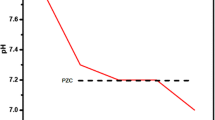Abstract
Merrill-Crowe is the primary process used for the concentration and purification of silver in a cyanide solution. The Langmuir Adsorption model for silver recovery in a cyanide solution was used for the study. The maximum adsorption capacity was 6.19 mmol/g for silver. This model properly adjusts the experimental results of the adsorption equilibrium with high correlation coefficients, which also favors the formation of a single layer of molecules adsorbed for the silver in the electrocoagulation-generated species. The thermodynamic parameters ΔG, ΔH, and ΔS were estimated, and it was found that the adsorption process is exothermic and spontaneous. For the kinetic study, the Lagergren second-order equation was used to study the adsorption speed. To characterize the solids coming from the electrocoagulation, X-ray diffraction (XRD), and scanning electron microscopy (SEM) with energy-dispersive X-ray spectroscopy (EDX) were used; the results of this study suggest that silver is present in aluminite, hydroniumjarosite, and alunogen.






Similar content being viewed by others
References
Hashabi (2005) A short history of hydrometallurgy. Hydromet 79:15–22
Kuyucak N, Akcil A (2013) Cyanide and removal options from effluents in gold mining and metallurgical processes. Min Eng 50–51:13–29
Mular AL, Halbe DN and Barrett DJ (2002) Mineral processing plant design, practice and control. SME
Vázquez V, Parga J, Valenzuela JL, Figueroa G, Valenzuela A, Munive G (2014) Recovery of silver from cyanide solutions using electrochemical process like alternative for Merrill-Crowe process. Mater Sci Appl 5(12):863
Parga JR, Cocke DL, Valverde V, Gomes JA, Kesmez M, Moreno H, ... and Mencer D (2005) Characterization of electrocoagulation for the removal of chromium and arsenic. Chem Eng Technol 28(5): 605-612
Gomes JA, Daida P, Kesmez M, Weir M, Moreno H, Parga JR, ... and Cocke DL (2007) Arsenic removal by electrocoagulation using combined Al–Fe electrode system and characterization of products. J Hazard Mater 139(2), 220-231
Parga JR, Munive GT, Valenzuela JL, Vázquez VV, Zamarripa GG (2013) Copper recovery from Barren cyanide solution by using electrocoagulation iron process. Adv Chem Eng Sci 3(2):150–156. https://doi.org/10.4236/aces.2013.32018
Kobya M, Gebologlu U, Ulu F, Oncel S, Demirbas E (2011) Removal of arsenic from drinking water by the electrocoagulation using Fe and Al electrodes. Electrochem Acta 56(14):5060–5070
Rebhun M, Lurie M (1993) Control of organic matter by coagulation and floc separation. Water Sci Technol 27(11):1–20
Figueroa Martinez GV, Parga Torres JR, Valenzuela García JL, Tiburcio Munive GC, González Zamarripa G (2012) Kinetic aspects of gold and silver recovery in cementation with zinc power and electrocoagulation iron process. Adv Chem Eng Sci 02(03):342–349. https://doi.org/10.4236/aces.2012.23040
Taeyeon K, Tae-Kyoung K, Kyung-Duk Z (2020) Removal mechanism of heavy metal (Cu, Ni, Zn, and Cr) in the presence of cyanide during electrocoagulation using Fe and Al electrodes, J Water Process Eng 33 https://doi.org/10.1016/j.jwpe.2019.101109
Kamaraj R, Vasudevan S (2014) Evaluation of electrocoagulation process for the removal of strontium and cesium from aqueous solution. Chem Eng Res Des 93:522–530. https://doi.org/10.1016/j.cherd.2014.03.021
Ho YS, McKay G (1998) The kinetics of sorption of basic dyes from aqueous solution by sphagnum moss peat. Can J Chem Eng 76(4):822–827
Kundu S, Gupta AK (2006) Adsorptive removal of As(III) from aqueous solution using iron oxide coated cement (IOCC): evaluation of kinetic, equilibrium and thermodynamic models. Sep Purif Technol 51(2):165–172. https://doi.org/10.1016/j.seppur.2006.01.007
Acknowledgements
The authors wish to acknowledge the support provided to this project by the National Council of Science and Technology (CONACYT) and to the Department of Chemical Engineering and Metallurgical of the University of Sonora.
Author information
Authors and Affiliations
Corresponding author
Ethics declarations
Conflict of Interest
The authors declare no competing interests.
Additional information
Publisher's Note
Springer Nature remains neutral with regard to jurisdictional claims in published maps and institutional affiliations.
Rights and permissions
About this article
Cite this article
Montaño, E., Vázquez, V., Valenzuela, J.L. et al. Thermodynamic and Kinetic Study for Silver Recovery by Electrocoagulation Process. Mining, Metallurgy & Exploration 39, 153–159 (2022). https://doi.org/10.1007/s42461-021-00509-5
Received:
Accepted:
Published:
Issue Date:
DOI: https://doi.org/10.1007/s42461-021-00509-5




